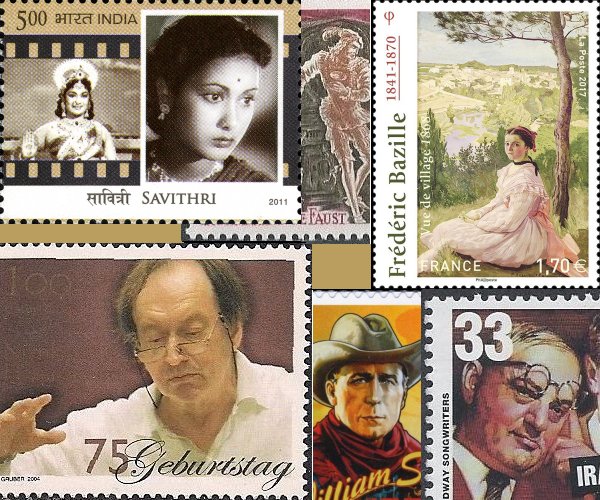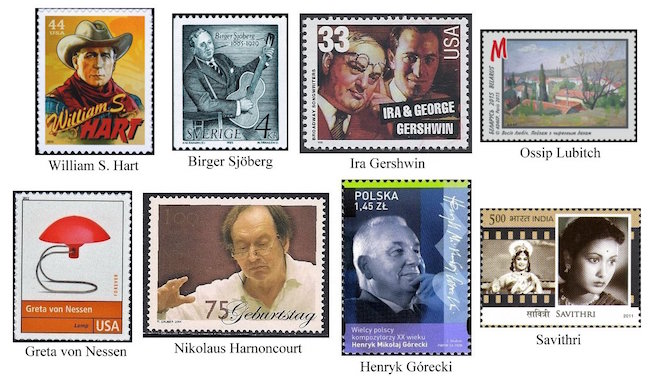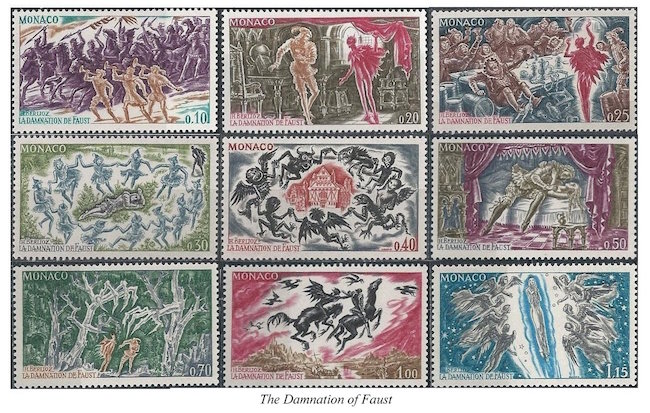The Arts on Stamps of the World — December 6
An Arts Fuse regular feature: the arts on stamps of the world.

By Doug Briscoe
Birthday boys Ira Gershwin, Nikolaus Harnoncourt, and Henryk Górecki are outdone philatelically by our elaborate display for Berlioz’s operatic masterpiece The Damnation of Faust. But that will be today’s grand finale. Meanwhile we have several diverting warm-up acts.
As a warm-up to the warm-ups, we offer a brief salute to Baldassare Castiglione (December 6, 1478 – February 2, 1529), count of Casatico, author of The Book of the Courtier. There’s no Italian stamp, oddly enough, but there is one from Bulgaria. Go figure.
Wilhelmine Schröder-Devrient (6 December 1804 – 26 January 1860) was the daughter of actress Sophie Schröder. She first appeared on stage as an actress in Racine’s Phèdre (in the Schiller translation) when she was 15. Two years later her operatic career was assured with a bring-the-house-down performance as Pamina in Mozart’s Magic Flute. She married the actor Karl Devrient in 1823, though they were together only five years. She had a long working relationship with Wagner, creating no fewer than three of his operatic heroines: Adriano (well, OK, one hero, two heroines) in Rienzi, Senta in The Flying Dutchman and Venus in Tannhäuser. A second marriage lasted even less time than the first—only about a year—and then she was arrested for her participation in the Revolution of 1848 in Dresden. In 1850 marriage no. 3 turned out to be the most enduring, an unprecedented eight years. She planned to go America but fell ill and died weeks after her 56th birthday. Schröder-Devrient is also famous for her no doubt highly fictionalized and certainly highly variegated erotic memoirs, published in English as Pauline the Prima Donna and in French as Les Mémoires d’une chanteuse allemande. The stamp has a perhaps unexpected raison d’être: it comes from a set of East German stamps issued to lament lost works of art. This portrait of the soprano was painted by Carl Joseph Begas (1794-1854).
Austrian architect August Sicard von Sicardsburg (6 December 1813 – 11 June 1868) was born in Buda and studied in Melk and Vienna. He became friends with Eduard van der Nüll (1812–1868), and together they would create a number of buildings, of which the most famous is the Vienna State Opera House. Neither of them lived to see it completed, however. Van der Nüll committed suicide in 1868, just six weeks before von Sicardsburg succumbed to tuberculosis. The opera house opened with Mozart’s Don Giovanni on May 25, 1869. Its facade is shown on an Austrian stamp dated 1993, the 125th anniversary of the deaths of both architects.

French Impressionist painter Frédéric Bazille (December 6, 1841 – November 28, 1870) might be better known to us had he not been killed in the Franco-Prussian War at the age of 28. He came from Montpellier and from money, with which he was very open-handed to artists in need. He saw some pieces by Delacroix and decided he wanted to be a painter. His family agreed, but with the usual proviso that he study something practical, in this case medicine. On failing his medical exam in 1864 (by design, one wonders?) he was ready to get down to business. He became friendly with Sisley, Monet, and Manet and promptly painted some of his best-known works, including The Pink Dress (La Robe rose, c1864) and Reclining Nude (1864), the latter showing on the upper background of the minisheet from the Ivory Coast. That sheet contains also two paintings from 1870, Bazille’s Studio and La Toilette, which is reproduced in the center of Bazille’s Studio (behind the white sofa) as well as on a stamp from Guinea-Bissau. Another renowned work is Family Reunion of 1867-68. On a stamp of France is La vue de village (1868), on one from the Solomon Islands is Queen’s Gate at Aigues-Mortes (1867), and on an unofficial (i.e., illegal) issue from Uzbekistan is the possibly homoerotically charged Scène d’été (1869), which can be seen in the flesh, as it were, at Harvard’s Fogg Art Museum. Here, too, is Bazille’s Self-Portrait of 1865-66.
How many cowboy stars of Westerns can you name who were classically trained in the Shakespearean repertoire? William S. Hart (December 6, 1864 – June 23, 1946) was one. In fact, he didn’t appear in a film until he was 49 years old. He was born in Newburgh, New York and started acting in his twenties, appearing on Broadway and in the original 1899 production of Ben-Hur. Hart always had been fascinated by the Old West, though, and counted Wyatt Earp and Bat Masterson among his friends. He was a collector of memorabilia and owned Billy the Kid’s guns. As an aficionado of the period, Hart was a stickler for accuracy at a time when we think of the Tom Mix style of flashy clothes and fancy gunplay holding sway in the silents. (Tom Mix came a bit later, when audiences got bored with accuracy.) Hart first played lesser roles in two 1914 shorts before getting the lead in that year’s The Bargain, which made him a star. He was the biggest star of Westerns for the next decade, his swan song being the self-produced Tumbleweeds (1925). A few years before Hart retired from film making he began writing Western short stories and novels. His only appearance in the talkies was in an introduction to the rerelease of Tumbleweeds in 1939.
The Swedish poet and novelist Birger Sjöberg (6 December 1885 – 30 April 1929) was probably better known as a songwriter. Thus the postage stamp shows him with his guitar. He started, actually, as a journalist who wrote songs as a hobby. The style of these harked back to the traditional composer/performers like Carl Michael Bellman (1740–1795). Sjöberg’s first public success was with the song collection Frida’s Book (1922), after which he undertook concert tours for some years, but in the end gave that up to concentrate on his writing. In the meantime he had written his novel The Quartet That Split Up (Kvartetten Som Sprängdes, 1924), which is about the members of a string quartet rather than a popular vocal quartet, as I would have assumed. A second volume of songs, Crises And Laurel Wreaths (Kriser och kransar, 1926), shocked the public with its abandonment of the harmless idylls of Frida’s Book and the introduction of elements of anxiety, doubt, and loneliness.

Jacob Gershowitz and his kid brother Israel grew up to be George and Ira Gershwin (1896 – August 17, 1983). Ira went to high school with Yip Harburg. While George was active as a composer from his late teens, Ira didn’t take up writing lyrics until the age of 24, at which point he immediately had a success with Two Little Girls in Blue (1921). Incidentally, George was already famous by then, and Ira chose to avoid riding on his coattails by using the pseudonym Arthur Francis, after his two younger siblings. (Frances was a girl and went on to become a Broadway performer who married the son of pianist Leopold Godowsky.) In the same year, George and Ira collaborated for the first time with A Dangerous Maid. They followed that with a dozen more shows and four movies, which included the hit songs “The Man I Love”, “Fascinating Rhythm”, “Someone to Watch Over Me”, “I Got Rhythm”, and “They Can’t Take That Away from Me”. After George’s early death from a brain tumor, Ira temporarily went into retirement but came back to work with Jerome Kern; Kurt Weill, and Harold Arlen (most memorably for the 1954 version of A Star Is Born, for which Ira and Arlen wrote five of the songs).
Born on precisely the same day half way around the world was another Jewish artist, Ossip Lubitch (6 December 1896 –27 November 1990), who was born in Grodno but lived much of his life in Paris. As a youngster he spoke not only Russian and Yiddish but also German and was torn between pursuing a career in music and one in the visual arts. Painting won out. He wanted to go to Paris right away, but World War I interceded, after which Lubitch established himself in Berlin. There he worked with colleagues Pavel Tchelitchev and Jean Pougny (Ivan Pugni) on theater and opera sets. In 1923, they were engaged to make the decorations for a cabaret in Montmartre. The sculptor Antoine Bourdelle noted this work and gave Lubitch an introduction to the Paris Salons. Around this time Lubitch formed an association with a group of distinguished young musicians including Alexandre Tansman, Bohuslav Martinů, Monique Haas, and Charles Munch. After the occupation Lubitch was interned at the camp at Drancy and was scheduled to be transported to Auschwitz when he was saved by the liberation. He had many more years of productivity before his demise in Paris just a week or so before his 94th birthday. The stamp from Belarus shows his Landscape with Red Roofs.
The Wikipedia article for American industrial designer Greta von Nessen says she was born on December 6, 1898, though other sources give her birth date (vaguely) as 1900. She was born in Sweden and formed a partnership, both in marriage and in creative work, with the German designer Walter von Nessen. They came to the United States in 1927 and founded Nessen Studios in Manhattan. After his death in 1943 she continued alone, producing her famous Anywhere Lamp (1951), as seen on the stamp, one of a set honoring American design. Nessen Studios is now known as Nessen Lamps Inc. Some of her other designs have been shown in the Museum of Modern Art. She died in 1975.
The late Nikolaus Harnoncourt (6 December 1929 – 5 March 2016) has come in for his share of brickbats, KUFC’s Jim Svejda having gone so far as to call him an “incompetent bozo.” But, just like Liberace, Harnoncourt could cry all the way to the bank. A scion of the Hapsburgs, he founded the Concentus Musicus Wien (in 1953!) and, alternating with the equally late Gustav Leonhardt, recorded all the Bach cantatas between 1971 and 1990. He started out as a cellist and made execrable recordings of all the Bach Suites in 1965. Oh, well, De mortuis non disputandum est.

To his credit, Henryk Górecki (go-RET-ski; December 6, 1933 – November 12, 2010), best known for his best-selling “Symphony of Sorrowful Songs” (yuck), refused to capitalize on his success with more music in the same vein (“Symphony of More Sorrowful Songs”, “More Symphonies of Most Sorrowful Songs”…) and instead faithfully followed his muse, such as it was. His earlier works were serialist, then in the 70s he turned to the sort of Arvo Pärtish mystical minimalism evinced in SoSS. Oh, well, De mortuis…
Our final birthday salute today goes to Indian film actress Savithri, born Savithri Nissankararao (or Kommareddy) on this date in 1935 or 1936 or maybe on January 11, 1937. She lost her father when she was only six months old and studied classical Indian dance from the age of 8. Revered as one of the favorite actresses in Telugu cinema, she also appeared in Tamil, Kannada, Malayalam, and Hindi language films. Her first leading role was in 1952’s comedy Pelli Chesi Choodu (Try Getting Married). In 1955 (or 1956) she followed the movie’s advice and wed Tamil actor Gemini Ganesan. Savitri also worked as a dancer and playback singer, and in 1968, she produced and directed the movie Chinnari Papalu (translation, anyone?), noted for its high proportion of women in the crew and for being awarded a Silver Nandi for Best Feature Film. She went on to direct another four or five movies. Savithri was only 45 when she died of substance abuse (drugs and alcohol) on 26 December 1981.
Hector Berlioz’s masterpiece The Damnation of Faust had its première at the Paris Opéra-Comique on 6 December 1846. In 1969, the Principality of Monaco issued this stunning set of nine (!) stamps illustrating scenes from the opera for the centenary of the composer’s death.
Two more names grace our page, if not (yet) any postage stamps: American writer Joyce Kilmer (December 6, 1886 – July 30, 1918) and the late great jazz pianist Dave Brubeck (1920 – December 5, 2012).
A graduate of the University of Massachusetts with a B.A. in English, Doug Briscoe worked in Boston classical music radio, at WCRB, WGBH, and WBUR, for about 25 years, beginning in 1977. He has the curious distinction of having succeeded Robert J. Lurtsema twice, first as host of WGBH’s weekday morning classical music program in 1993, then as host of the weekend program when Robert J.’s health failed in 2000. Doug also wrote liner notes for several of the late Gunther Schuller’s GM Recordings releases as well as program notes for the Boston Classical Orchestra. For the past few years he’s been posting a Facebook “blog” of classical music on stamps of the world, which has now been expanded to encompass all the arts for The Arts Fuse.
